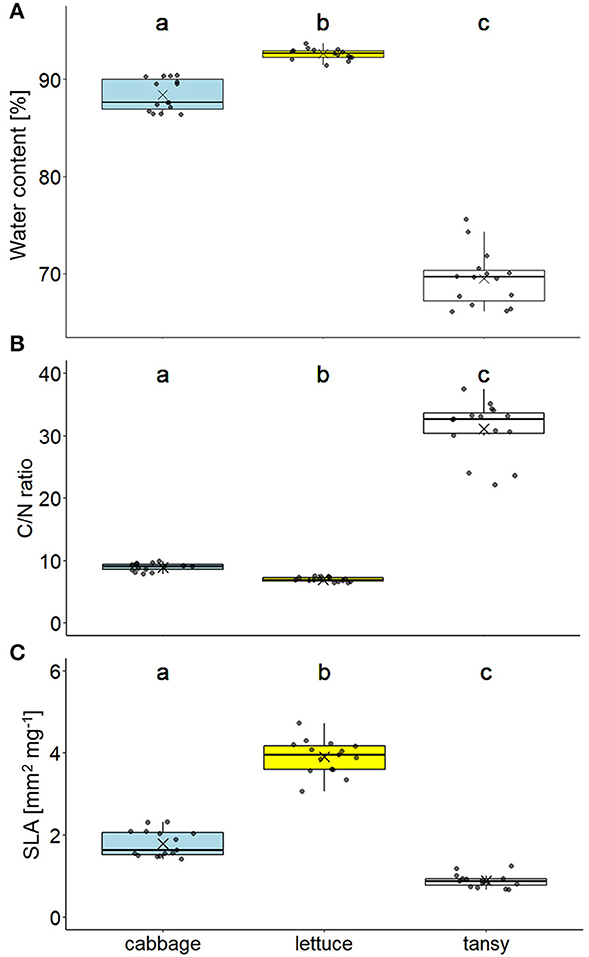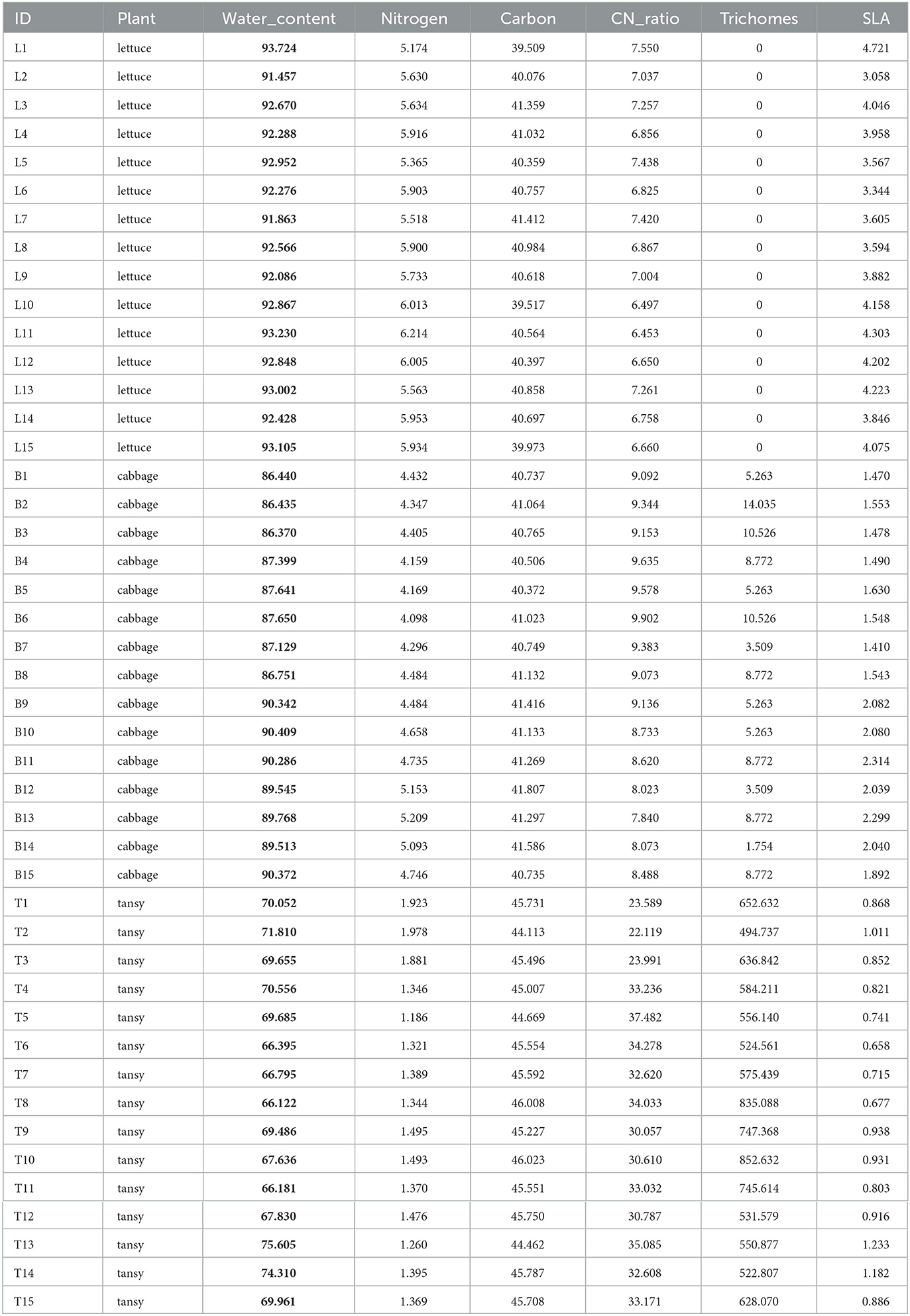- 1Department of Chemical Ecology, Bielefeld University, Bielefeld, Germany
- 2Department of Proteome and Metabolome Research, Center for Biotechnology (CeBiTec), Bielefeld University, Bielefeld, Germany
A corrigendum on
Development of a polyphagous leaf beetle on different host plant species and its detoxification of glucosinolates
by Friedrichs, J., Schweiger, R., Geisler, S., Neumann, J.M., Sadzik, S. J.M., Niehaus, K., and Müller, C. (2022). Front. Ecol. Evol. 10:960850. doi: 10.3389/fevo.2022.960850
In the published article, there was an error in Affiliation 2. “CeBiTex” was given as the acronym for the Center for Biotechnology. This should read “CeBiTec.”
There was an error in Figure 2A as published. The calculation of the water content was wrong. The corrected Figure 2 and its caption appear below.

Figure 2. Leaf quality traits of different food plant species (cabbage: Brassica rapa; lettuce: Lactuca sativa; tansy: Tanacetum vulgare) with (A) water content, (B) carbon-to-nitrogen (C/N) ratio, and (C) specific leaf area (SLA; n = 15 per plant species). Box plots show the means (as crosses), medians (horizontal lines) and interquartile ranges (IQR; boxes), the whiskers extend to the most extreme values with max. 1.5 times the IQR. Individual values are plotted as dark circles. Statistical analyses were done with Kruskal–Wallis tests followed by pairwise Mann–Whitney U-tests. Significant differences (p < 0.05) are indicated by different lowercase letters.
Due to the error in the calculation of the water content, some sentences in the text must also be adjusted.
A correction has been made to the Abstract. This previously stated:
“Cabbage had the lowest water content, while tansy had the highest water content, C/N ratio and trichome density and the lowest SLA. Lettuce showed the lowest C/N ratio, highest SLA and no trichomes.”
The corrected sentence appears below:
“Lettuce had the highest water content and SLA but the lowest C/N ratio and no trichomes. In contrast, tansy had the lowest water content and SLA but the highest C/N ratio and trichome density. Cabbage was intermediate in these traits.”
A correction has been made to Results, “Leaf quality traits of the different plant species,” Paragraph 1. This previously stated:
“The water content differed significantly between the leaves of the three host plant species (X2 = 38.96, df = 2, p < 0.001), being lowest for cabbage and highest for tansy (Figure 2A).”
The corrected sentence appears below:
“The water content differed significantly between the leaves of the three host plant species (X2 = 39.13, df = 2, p < 0.001), being highest for lettuce and lowest for tansy (Figure 2A).”
A correction has been made to Discussion, “Performance of Galeruca tanaceti on mono vs. mixed diets,” Paragraph 2. This previously stated:
“The water content differed between the species, but in all plants it was at least around 90% and can thus be considered as sufficient for herbivores (Scriber and Slansky, 1981).”
The corrected sentence appears below:
“The water content differed between the species, but at least for lettuce and cabbage it was around 90% and can thus be considered as sufficient for herbivores (Scriber and Slansky, 1981).”
A correction has been made to Discussion, “Performance of Galeruca tanaceti on mono vs. mixed diets,” Paragraph 3. This previously stated:
“Although the tansy leaf beetle G. tanaceti is named after tansy, on which it can be found in nature, diets containing tansy are surprisingly not very beneficial for this species.”
The corrected sentence appears below:
“Although the tansy leaf beetle G. tanaceti is named after tansy, on which it can be found in nature, diets containing tansy are surprisingly not very beneficial for this species, potentially due to the low water content, low SLA and high trichome density.”
In the published article, there was an error in Supplementary Table S2. Due to an incorrect calculation, the information on water content in the Plant Quality table was wrong.
The correct table appears below:
The authors apologize for these errors and state that this does not change the scientific conclusions of the article in any way. The original article has been updated.
Publisher's note
All claims expressed in this article are solely those of the authors and do not necessarily represent those of their affiliated organizations, or those of the publisher, the editors and the reviewers. Any product that may be evaluated in this article, or claim that may be made by its manufacturer, is not guaranteed or endorsed by the publisher.
References
Keywords: glucosinolate-myrosinase system, metabolism, polyphagous herbivore, performance, detoxification
Citation: Friedrichs J, Schweiger R, Geisler S, Neumann JM, Sadzik SJM, Niehaus K and Müller C (2023) Corrigendum: Development of a polyphagous leaf beetle on different host plant species and its detoxification of glucosinolates. Front. Ecol. Evol. 11:1159897. doi: 10.3389/fevo.2023.1159897
Received: 06 February 2023; Accepted: 14 February 2023;
Published: 28 February 2023.
Edited and reviewed by: Anne Marie Cortesero, University of Rennes 1, France
Copyright © 2023 Friedrichs, Schweiger, Geisler, Neumann, Sadzik, Niehaus and Müller. This is an open-access article distributed under the terms of the Creative Commons Attribution License (CC BY). The use, distribution or reproduction in other forums is permitted, provided the original author(s) and the copyright owner(s) are credited and that the original publication in this journal is cited, in accordance with accepted academic practice. No use, distribution or reproduction is permitted which does not comply with these terms.
*Correspondence: Caroline Müller, Y2Fyb2xpbmUubXVlbGxlckB1bmktYmllbGVmZWxkLmRl
 Jeanne Friedrichs1
Jeanne Friedrichs1 Karsten Niehaus
Karsten Niehaus Caroline Müller
Caroline Müller